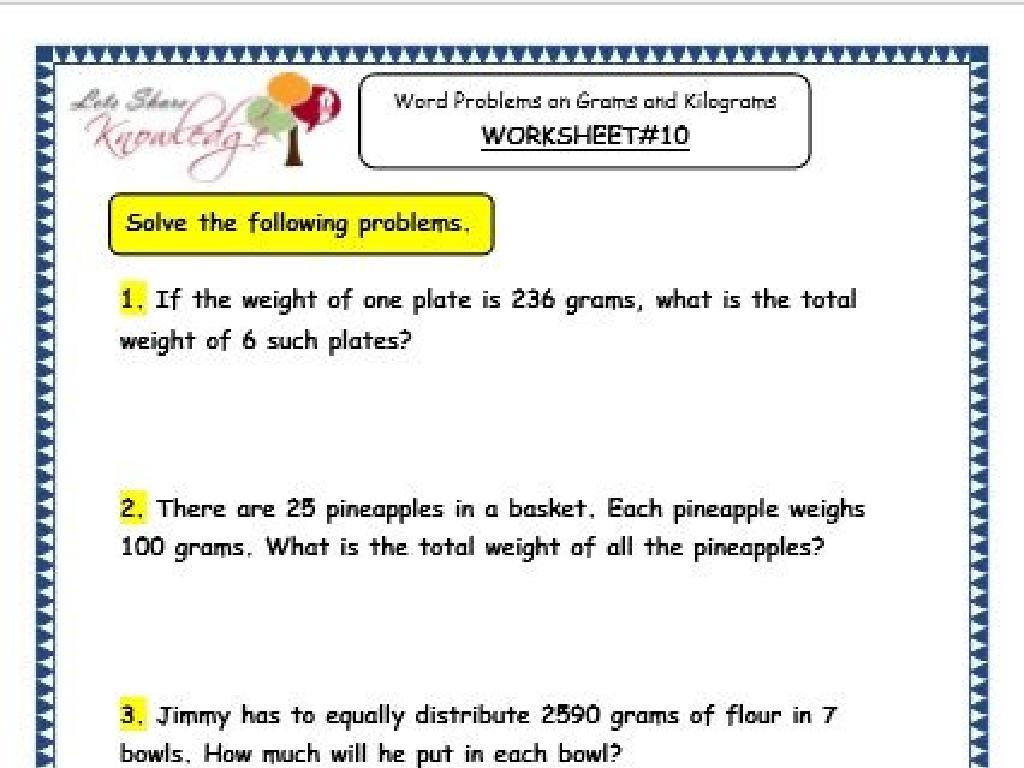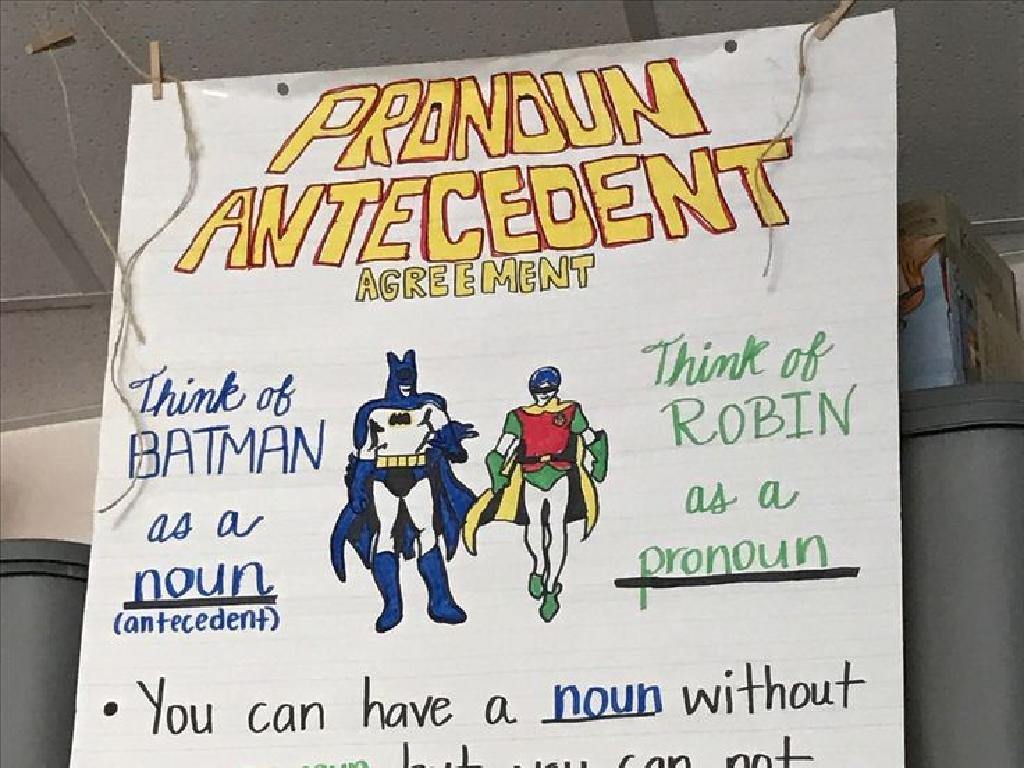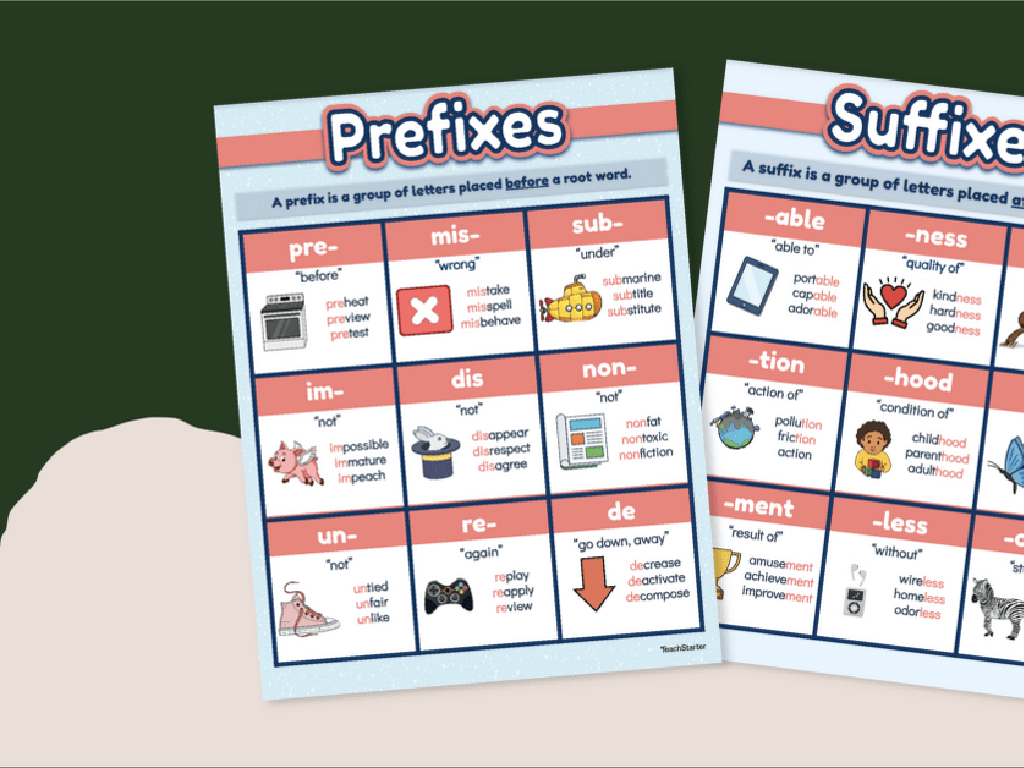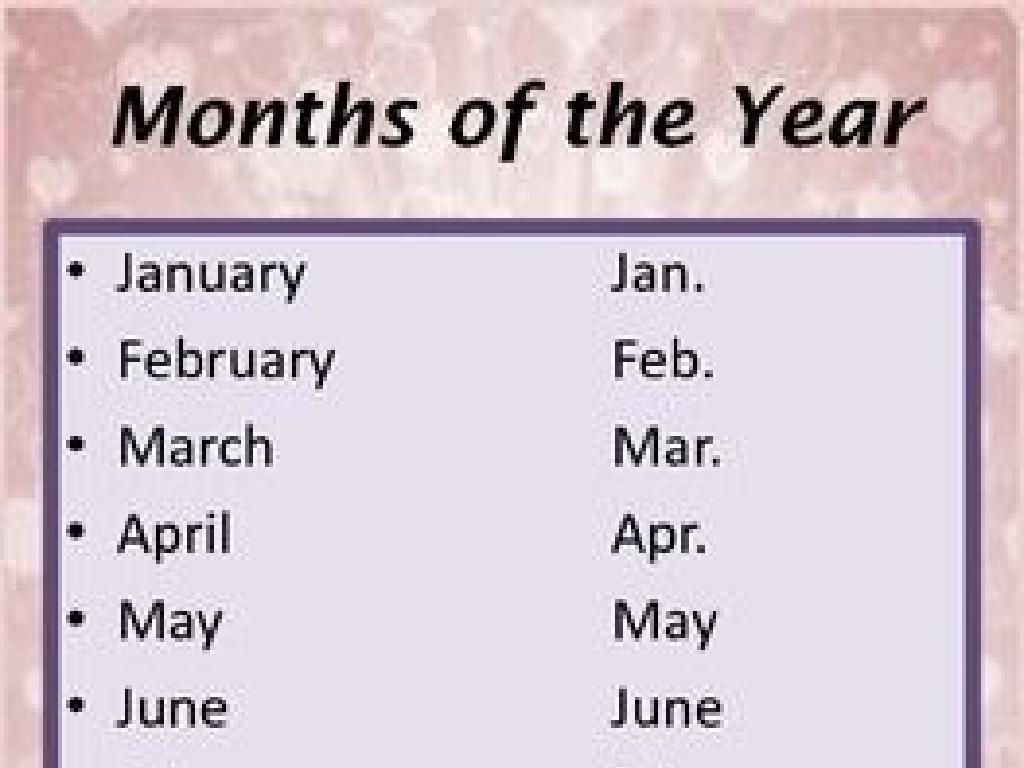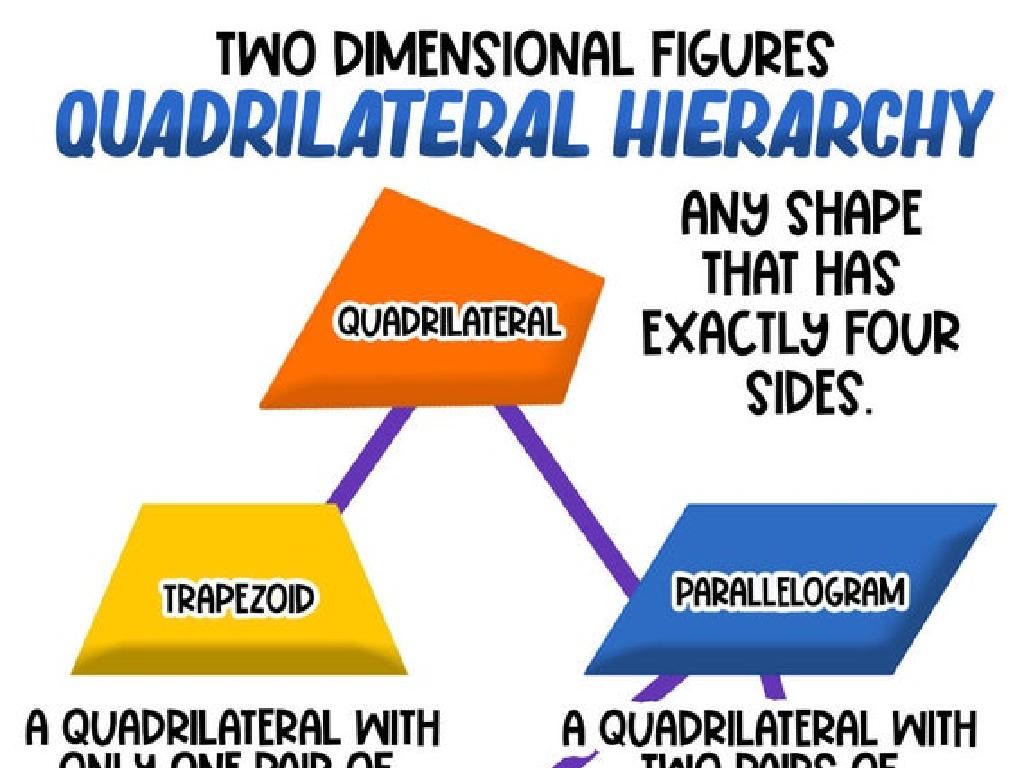Fractions Of Number Lines: Halves, Fourths, And Eighths
Subject: Math
Grade: Third grade
Topic: Fractions On Number Lines
Please LOG IN to download the presentation. Access is available to registered users only.
View More Content
Today’s Adventure: Fractions on Number Lines
– Exploring halves on a number line
– A number line divided into 2 equal parts shows halves.
– Breaking into fourths
– When we divide those halves in half, we get fourths.
– Dividing into eighths
– Each fourth split in half again gives us eighths.
– Fractions in daily life
– Fractions help in cooking, telling time, and shopping.
|
Begin by introducing the concept of fractions on a number line, emphasizing the visual aspect of dividing a whole into equal parts. Explain halves by showing a number line split into two equal sections. Progress to fourths by dividing those halves again, and then to eighths. Use real-life examples such as cutting a pizza or a cake to illustrate the concept. Highlight the importance of understanding fractions for everyday activities like cooking (measuring ingredients), telling time (half past, quarter to), and handling money (giving change). Encourage students to think of other examples where they use fractions in their daily lives.
Understanding Fractions
– A fraction shows part of a whole
– Like a piece of a pie
– Top number is the numerator
– It tells us how many parts we have
– Bottom number is the denominator
– It tells us into how many parts the whole is divided
– Example: 1/2 means 1 out of 2 parts
– If a pizza is cut into 2 pieces, 1/2 is one piece
|
This slide introduces the concept of fractions to third-grade students. Begin by explaining that a fraction represents a part of a whole, similar to a slice of pizza. The numerator, or the top number of a fraction, indicates how many parts we are considering, while the denominator, the bottom number, shows the total number of equal parts the whole is divided into. Use the example of 1/2 to illustrate this concept, perhaps by visually showing a shape like a circle (a pizza) cut into two equal parts and one part shaded to represent the fraction. Encourage students to think of other examples of halves in their daily life to solidify their understanding.
Fractions in Action: Everyday Examples
– Fractions in daily life
– Pizza slices as fractions
– A whole pizza can be cut into 2, 4, or 8 equal slices.
– Sharing treats equally
– If you have 8 cookies and 4 friends, everyone gets 2 cookies.
– Understanding halves, fourths, eighths
– These are parts of a whole: 1/2, 1/4, 1/8 of something.
|
This slide aims to help students see the practical application of fractions in their everyday lives. Use the example of a pizza to illustrate how a whole item can be divided into halves, fourths, and eighths. Discuss how sharing items like treats can be done equally using fractions. Emphasize the concept of ‘whole’ and how it can be split into equal parts. Encourage students to think of other examples where they encounter fractions daily. Activities can include dividing playdough shapes, cutting fruit, or sharing storybooks among friends to reinforce the concept of equal parts and fractions.
Fractions on Number Lines: Halves, Fourths, and Eighths
– Understanding a number line
– A number line is a straight line with numbers placed at equal intervals.
– Number lines show fractions too
– Just like whole numbers, fractions have a spot on the number line.
– How to mark fractions on a line
– To mark a fraction, find the space between whole numbers that it represents.
– Practice with halves, fourths, eighths
– Let’s locate 1/2, 1/4, and 1/8 on a number line together.
|
This slide introduces the concept of a number line as a foundational tool in understanding both whole numbers and fractions. Emphasize that a number line is not just for whole numbers; it can also be used to visually represent fractions, which helps students understand the size and order of fractions. Demonstrate how to mark fractions on a number line by dividing the segments between whole numbers into equal parts. Use examples like cutting a cake into halves, fourths, and eighths to make the concept relatable. Encourage students to practice by marking different fractions on a number line and explaining their reasoning. This will prepare them for more complex operations with fractions in the future.
Placing Halves on a Number Line
– Halves split things into two equal parts
– Like cutting a pizza into 2 big slices
– Labeling 1/2 and 2/2 on the number line
– Find the middle point for 1/2, end point for 2/2
– Distance between 0 and 1 shows halves
– Imagine dividing a road into two equal lanes
– Understanding halves visually
|
This slide introduces students to the concept of halves using a number line. Begin by explaining that a half divides something into two equal sections, similar to cutting a pizza into two large slices. Show how to find and label the halfway point (1/2) and the whole (2/2) on a number line. Illustrate that the distance from 0 to 1 on the number line can be split into two equal halves, helping students visualize and understand the concept of halves. Use relatable examples like dividing a road into two equal lanes to further clarify the idea. Encourage students to draw their own number lines and practice placing halves on them.
Placing Fourths on a Number Line
– Fourths mean dividing into 4 equal parts
– Identifying fractions: 1/4, 2/4, 3/4, 4/4
– Points on a line showing 1/4 steps from 0 to 1
– Comparing fourths with halves
– Notice 2/4 is the same as 1/2 on the line
– Practice with number line activities
– Draw your own number line and mark the fourths
|
This slide introduces students to the concept of dividing a whole into four equal parts, known as ‘fourths.’ Start by explaining that a number line can be split into any number of equal parts, and in this case, into four. Show how each point on the line represents a step of one-fourth. Emphasize that 2/4 is the same as 1/2, which helps students relate to the concept of halves they already know. Encourage students to draw their own number lines and practice placing 1/4, 2/4, 3/4, and 4/4 on it. This visual and hands-on activity will help solidify their understanding of fractions on number lines.
Placing Eighths on a Number Line
– Eighths split into 8 equal parts
– Marking eighths: 1/8 to 8/8
– Each point is spaced evenly, like 0, 1/8, 2/8…
– Eighths, halves, and fourths connection
– 4/8 is the same as 1/2, and 2/8 is the same as 1/4
– Practice with eighths on a line
– Let’s place 3/8 and 5/8 on the line and see where they fit
|
This slide introduces students to the concept of dividing objects and number lines into eight equal parts, known as eighths. Start by explaining that just like a pizza can be cut into eight slices, a number line can be split into eight segments. Show how to mark the eighths on the number line, emphasizing the equal spacing between each fraction. Highlight the relationship between eighths, halves, and fourths, ensuring students understand that these fractions can represent the same points on a number line (e.g., 4/8 is the same as 1/2). Engage the class with hands-on practice, using a number line to place various eighths and discuss their position relative to halves and fourths. This will solidify their understanding of how different fractions can be equivalent and how they are represented on a number line.
Comparing Fractions on Number Lines
– Comparing 1/2 and 3/8
– Is 1/2 bigger than 3/8? Let’s use a number line to see!
– Using number lines to compare
– Place fractions on a number line to see which is larger or smaller.
– Finding equivalent fractions
– Equivalent fractions take up the same space on a number line.
– Which fraction is larger?
– Use what we’ve learned to decide if 1/2 or 3/8 is bigger.
|
This slide is aimed at helping students understand how to compare fractions by using number lines. Start by asking students which fraction they think is bigger, 1/2 or 3/8, and why. Then, demonstrate how to draw a number line and place these fractions on it. Discuss how the position of a fraction on the number line can help us compare their sizes. Introduce the concept of equivalent fractions by showing how different fractions can represent the same point on a number line. Finally, guide students to use these methods to determine which of the two fractions is larger. Encourage students to practice with more examples and to draw their own number lines for comparison.
Let’s Practice Fractions on Number Lines!
– Interactive example with 3/4
– Place 3/4 on a number line together
– Group activity: draw number lines
– Work in groups to create number lines
– Individual task: mark fractions
– Each student marks different fractions
– Understanding halves, fourths, eighths
|
This slide is designed for an interactive class activity to help students understand fractions on number lines. Begin with a guided example of placing 3/4 on a number line, showing students how to divide the line into equal parts. Then, have students work in small groups to draw their own number lines on paper or whiteboards. For the individual task, each student will mark given fractions like 1/2, 1/4, and 1/8 on their number lines. This activity reinforces the concept of equal divisions and the placement of fractions. Encourage students to help each other and ensure everyone understands how to divide a number line into halves, fourths, and eighths. Possible activities: 1) Use string to create large number lines on the floor. 2) Have students use different colors to mark each fraction type. 3) Create a number line relay race. 4) Use real-life objects to represent fractions on number lines. 5) Incorporate technology by using interactive whiteboard software.
Class Activity: Fraction Number Line Art
– Create a number line art piece
– Use halves, fourths, eighths
– Divide your art’s number lines into 2, 4, and 8 equal parts
– Share your art with the class
– Explain your fractions
– Tell us how you used fractions in your design
|
This activity is designed to help students understand fractions by incorporating them into a creative art project. Students will create an art piece that includes number lines, and they will divide these lines into halves, fourths, and eighths. This hands-on experience reinforces the concept of fractions on a number line. After completing their art, students will present their work to the class, explaining how they used each type of fraction in their design. For the teacher: Prepare examples of art with number lines, provide materials for the art project, and guide students through the process of dividing number lines into fractions. Have a discussion and reflection session after presentations to consolidate learning.
Wrapping Up: Fractions on Number Lines
– Excellent effort with fractions!
– Homework: Fraction Number Line Worksheet
– Complete the provided worksheet on halves, fourths, and eighths
– Practice is key to mastery
– The more you practice, the better you’ll understand
– Bring questions to next class
– Any difficulties? We’ll solve them together next time!
|
Today’s class focused on understanding fractions on number lines, specifically halves, fourths, and eighths. For homework, students are assigned a worksheet to reinforce these concepts. Remind them that consistent practice is crucial for mastering fractions. Encourage them to attempt all problems and bring up any questions or challenges they encounter in the next class. This will help address individual difficulties and ensure a solid grasp of the topic. Acknowledge their hard work today and motivate them to keep practicing.

